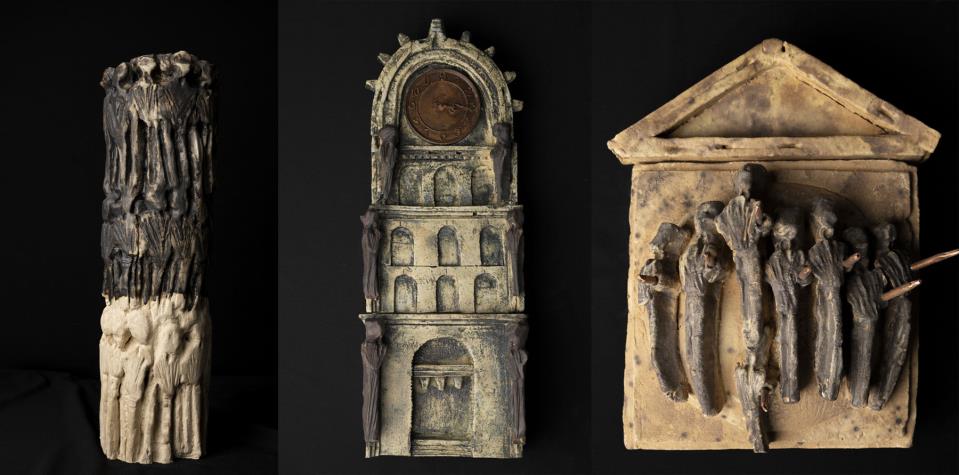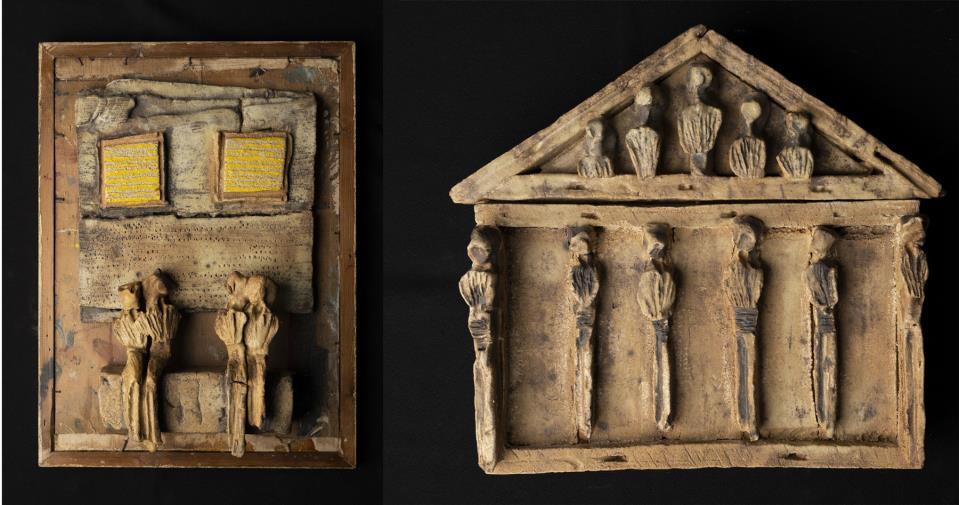New year, new exciting and eclectic exhibition programme at il-Kamra ta' Fuq! Our first exhibition of the year started last Friday, 20 January and finally we have our first ceramics exhibition - a medium that we had never had the pleasure to exhibit before. The solo exhibition is by an artist who does not need much introduction (but I'll still give him one), Joseph Agius.
Joseph Agius is a senior staff nurse at Mater Dei Hospital. His profession as a nurse is a very important piece of information to understand where the subject matter of most of his artworks is coming from. His job exposes him to a world whose fabric can include pain, disease, despair and death on a daily basis.


Another major source of inspiration is the news about all that is happening around us, which of course as we all know, is not exactly a joyride, both locally and internationally.
I got to know Joseph (don't call him Joe), mostly at various exhibition openings and was very excited to get to know of his interest and determination at exhibiting at il-Kamra ta' Fuq. And finally, here we are. I had the pleasure to visit his amazing private gallery and studio, which was topped up with a short tutorial about the ceramics medium, some months ago.


The sculptures forming part of C'est la vie were executed mostly throughout last year, with the exception of two or three works. The majority are wall-hanging sculptures which is also quite particular for Agius' works, as most of his sculptures are indeed wall-hanging. During one of my visits to see the exhibition pieces we were pondering and bouncing off ideas for a suitable title. The theme was very clear and all works focus on various rules, attitudes and different social "traditions", along with serious social issues, including migration, poverty, genocide, injustice, love, birth, death and prayer. The aspects tackled are various and originate from different strata of life as well as from different countries. Basically, he is working on what's happening all around us. So that's when I suggested C'est La Vie - a title that is meant as a tongue-in-cheek or sarcastic comment to highlight the alienation that we are surrounded with and the "laissez-faire" way of life that we are so used to live in. Also, I feel that employing a cheeky title, reflects a lot on Joseph's character and in all his artworks' titles. For those of you, who know him on a personal level, know that it also reflects his quiet and humble personality, though he always sends the message with a bang and a sting.

I feel the titles are as important as the artworks themselves. Joseph chooses linguistic metaphors and figures of speech as springboards for his creations, so the titles of his works have a metaphorical origin which he subsequently interprets as a narrative in clay.
Another signature mark of Joseph is the particularly stylized human figure representation that is so synonymous of his works, both as solo figures and when the human figure is included in the composition. Also, many times, the human figures are used to create the actual composition design as one can clearly observe in The Anger Breaker 1 and The Anger Breaker 2, where we have a mass of figures creating what can be perceived as a human barrier, with an actual division in the middle of the artwork.

The sculpture titled Colonization is tackling the aspect of invasion and taking over, especially hinting to South Africa. The colours chosen for this sculpture is reminiscent of the painted trees in South African forests, where the bark on the lower part of the trunk is painted in white by the indigenous population and the use of a column design is creating a word-play on the title (Colonna in Italian).
The artwork Help doesn't need much explanation. A life-saver float is covered with bodies, all surrounding an aggressive HELP! written in what seems to be a shaking hand and in red paint, as if in blood of the innocent. This work is a cry for help and homage to the many migrants lost at sea while in search of a better life.

Another work where a mass of human figures makes up the artwork is Classifying. This is tackling the society who labels individuals. Agius chose to remember those who are labelled as Mad and the Jews, and he emphasises this marking and labelling by literally including a large stamp and the two mentioned labels embossed in red within the crowd of figures.
Anchored to Wealth is stinging those whose priority in life is money and how their obsession generates harm to all those around them in various ways, including the over construction and the destruction of nature.
The artwork Dictatorship is showing an old style iron, ironing away through a mass of figures, creating a tabula rasa. Another mass cleansing is depicted in the work Pogrom where with the use of a "prop" - a rake - the artist is digging away and slaughtering the human figures.

There are two rays of hope that one can observe in two of the artworks. People of the World Unite shows an abstract globe surrounded by the usual figures which almost create a flower composition, where the artist is hoping to see and live in a world without the many sad scenarios that this exhibition is portraying. Mahbubin fil-Kamra ta' Fuq was created specifically as an homage to the exhibition venue. We see a glimpse of architecture, quite homely (compared to other sculptures showing more classical structures) and two couples, each enjoying intimate moments, which capture what il-Kamra ta' Fuq is all about and how all the artists describe it, as an intimate and safe place where one can express one's thoughts through art. We decided to display these two works in the traditional hanut tat-te situated just under the exhibition space.
These were just a few of the challenging works making up this exhibition. The beautiful photos by Andrew E. Zarb, which are accompanying this write-up don't do enough justice to the works, as one needs to appreciate in person, the detail in the texture, in all the figures amassing into the compositions, and all minute details.
The exhibition is being held at il-Kamra ta' Fuq until 12 February 2023. For further information check the Facebook page: 'il-Kamra ta' Fuq'
Photos: Andrew Zarb